While commercial landscaping often fights against nature’s preferences, you’ll discover that Missouri’s native plants actually work with your soil conditions to create stunning displays year after year. These hardy species have spent thousands of years adapting to the state’s clay soils, limestone outcrops, and unpredictable weather patterns. You won’t need expensive fertilizers or constant watering when you choose plants that belong here. But selecting the right combination for maximum visual impact requires understanding what thrives where.
Contents
- 1 Missouri’s Diverse Soil Types
- 2 Missouri’s Most Stunning Wildflowers
- 3 Missouri’s Majestic Native Trees
- 4 Missouri’s Essential Native Shrubs
- 5 Selecting the Right Native Plants for Your Garden
- 6 Frequently Asked Questions
- 6.1 How Much Do Native Missouri Plants Typically Cost Compared to Non-Native Varieties?
- 6.2 When Is the Best Time of Year to Plant Native Species?
- 6.3 How Long Does It Take for Native Plants to Become Established?
- 6.4 Do Native Missouri Plants Require Special Fertilizers or Soil Amendments?
- 6.5 Where Can I Purchase Native Missouri Plants and Seeds Locally?
Missouri’s Diverse Soil Types
Missouri’s foundation tells a story written in soil, where five distinct regions create a patchwork of growing conditions that’ll shape every planting decision you make. Northern Missouri’s deep, fertile loess supports intensive agricultural practices like corn and soybean production. The Ozark Plateau’s shallow, stony soils over limestone create challenging conditions that favor woodland restoration. Southeast Missouri’s Bootheel region features poorly drained alluvial soil types perfect for wetland ecosystems. Central Missouri offers moderately well-drained silt loams, while river valleys contain fertile, flood-prone soils. Understanding these distinct soil types helps you choose natives that’ll thrive naturally in your specific location.
Missouri’s Most Stunning Wildflowers
Missouri’s diverse ecosystems showcase spectacular native wildflowers adapted to varying light conditions, from sun-loving evening primrose to woodland shade species, each offering unique landscaping benefits. These indigenous plants are naturally drought-resistant and require minimal maintenance once established, making them ideal choices for sustainable gardening practices.
Purple Coneflower (Echinacea Purpurea)
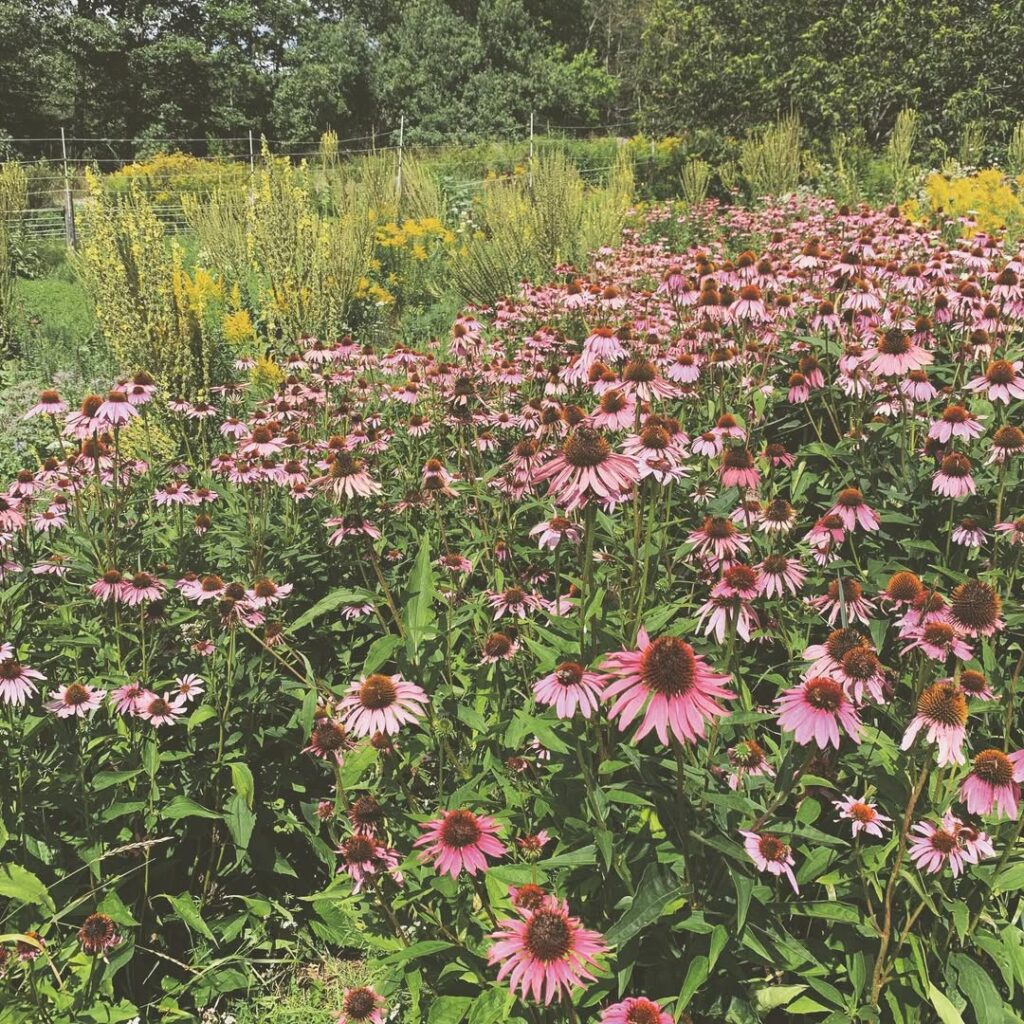
Purple Coneflower (Echinacea purpurea) stands as one of Missouri’s most beloved native wildflowers, featuring distinctive drooping lavender petals surrounding spiny, dome-shaped centers that inspired its Greek name meaning “hedgehog.” This hardy perennial produces showy daisy-like blooms up to 5 inches across from May through October, creating stunning focal points in prairie landscapes and garden settings.
Growing 2-4 feet tall with coarse, dark green foliage, Purple Coneflower thrives throughout Missouri’s tallgrass prairie regions and adapts well to various landscape conditions. Beyond its ornamental value, this native plant provides essential nectar for pollinators and has been traditionally used for herbal teas. Its self-seeding nature and low-maintenance requirements make it an excellent choice for naturalized areas and formal gardens alike. The dead flower stems provide valuable winter food sources for birds when left uncut.
- Hardiness: Zones 3-9, extremely cold hardy perennial
- Light: Full sun to light shade, most vigorous in full sun
- Water: Drought tolerant once established, moderate moisture preferred
- Soil: Adaptable to various soil types, well-draining preferred
- Fertilizer: Low fertility needs, avoid over-fertilizing
- Pest/Disease Resistance: Excellent resistance, rarely troubled by pests
- Growth Rate: Moderate, often blooms second year from seed
Black-Eyed Susan (Rudbeckia)
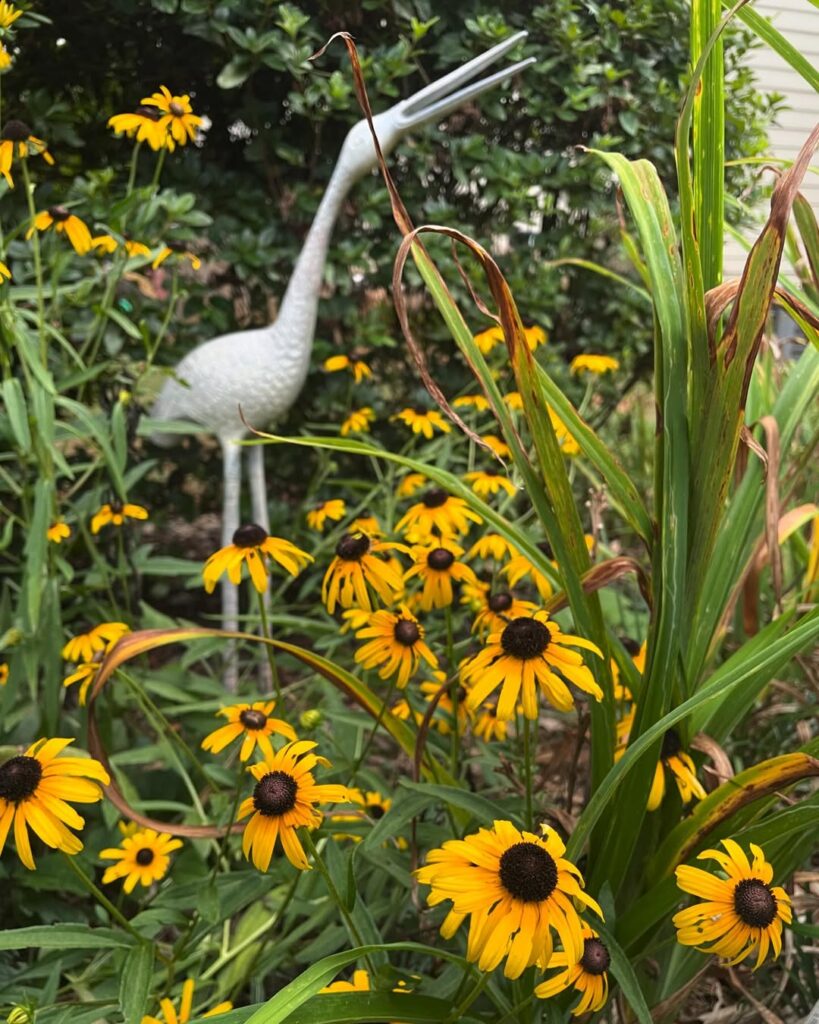
Black-eyed Susan (Rudbeckia hirta) stands as Missouri’s most recognizable wildflower, featuring distinctive dark centers surrounded by bright yellow ray petals on stems reaching 2½ feet tall. These hardy annual herbs bloom continuously from June through October, creating spectacular displays in prairies, roadsides, and gardens throughout the state.
With nine Rudbeckia species native to Missouri, including the smaller Missouri Coneflower and towering Wild Goldenglow, these versatile plants serve as pollinator magnets while tolerating challenging growing conditions. Their ability to self-seed and naturalize makes them invaluable for wildflower meadows and low-maintenance landscapes. Growing native plants like Black-eyed Susan provides significant benefits for local ecosystems and reduces maintenance requirements compared to non-native alternatives.
- Hardiness: Annual herb, self-seeding for continuous populations
- Light: Full sun to light shade
- Water: Drought tolerant, prefers dry to medium moisture levels
- Soil: Thrives in almost any soil except wet areas; tolerates clay, shallow-rocky, and well-drained soils
- Fertilizer: Low maintenance, grows well in average soils without supplemental feeding
- Pest/Disease Resistance: Deer resistant, generally pest-free
- Growth Rate: Fast-growing, blooms first year from seed
Wild Bergamot (Monarda Fistulosa)

Wild Bergamot is a Missouri native perennial from the mint family that forms attractive clumps reaching 2-4 feet tall. This stunning wildflower produces dense, globular clusters of lavender, tubular blooms throughout mid-summer, attracting bees, butterflies, and hummingbirds with its abundant nectar. The aromatic gray-green foliage adds textural interest while naturally deterring deer and livestock.
Found throughout Missouri’s prairies, woodlands, and glades, Wild Bergamot thrives in diverse habitats from rocky soils to disturbed roadsides. Its fibrous root system provides excellent erosion control, while the long-lasting flowers make exceptional cut arrangements. The plant readily self-seeds and naturalizes, making it ideal for wildflower meadows, prairie restorations, and low-maintenance native landscaping where it provides season-long visual appeal. The fragrant blooms are also excellent for dried flower arrangements, retaining their aromatic qualities long after harvesting.
- Hardiness: USDA zones 3-9
- Light: Full sun to partial shade
- Water: Dry to medium moisture; drought tolerant once established
- Soil: Well-drained soils; tolerates poor soils and various soil types
- Fertilizer: None required; thrives in native conditions
- Pest/Disease Resistance: Good; requires air circulation to prevent powdery mildew
- Growth Rate: Moderate; spreads by self-seeding and rhizomes
Cardinal Flower (Lobelia Cardinalis)

Cardinal Flower stands as one of Missouri’s most spectacular native wildflowers, earning recognition as a Missouri Botanical Garden Plant of Merit. This stunning perennial produces brilliant scarlet-red tubular flowers arranged in terminal spikes that bloom from July through September. Growing 2-4 feet tall with lance-shaped, dark green leaves, Cardinal Flower thrives in moist locations throughout the state.
The plant serves as an essential late-summer nectar source for migrating hummingbirds, which are its primary pollinators due to the flower’s specialized tubular shape. Named for its intense cardinal-red blooms reminiscent of Catholic cardinals’ robes, this member of the Bluebell family creates dramatic visual impact in native landscapes while supporting local wildlife populations. Despite its stunning appearance, Cardinal Flower contains alkaloids toxic to humans if ingested, making it important to admire from a distance.
- Hardiness: USDA zones typically covering Missouri’s climate range
- Light: Full sun to part shade; prefers filtered light or partial shade in warmer climates
- Water: Constant moisture required; tolerates brief flooding but needs regular watering during dry periods
- Soil: Rich, organic, moisture-retentive soils; thrives in consistently moist but not stagnant conditions
- Fertilizer: Minimal requirements in rich, organic soils
- Pest/Disease Resistance: Generally resistant with few major issues
- Growth Rate: Moderate; reaches 2-4 feet tall, occasionally up to 6 feet
Wild Columbine (Aquilegia Canadensis)
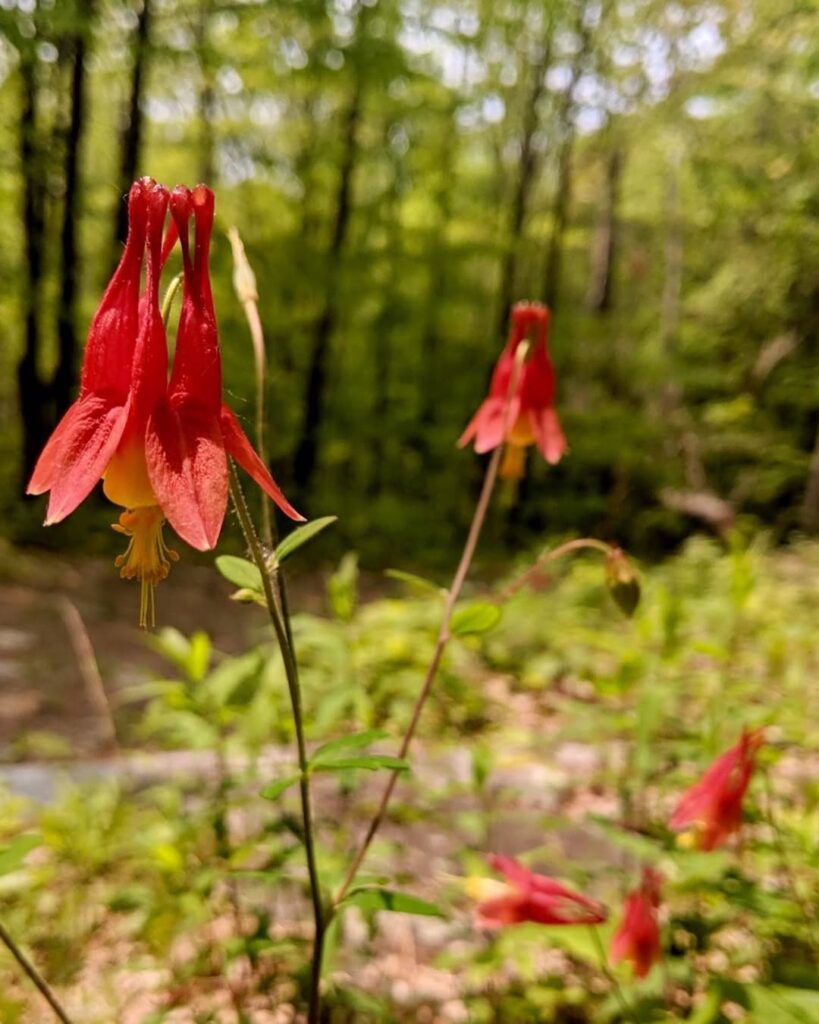
Wild Columbine (Aquilegia canadensis) stands out as one of Missouri’s most enchanting native wildflowers, featuring distinctive nodding blooms with striking red outer petals and bright yellow inner petals. This perennial herb reaches up to 3 feet tall with attractive blue-green divided foliage that remains semi-evergreen through much of the year.
Blooming from February through July, Wild Columbine provides essential early-season nectar for hummingbirds, bumblebees, and butterflies when few other native flowers are available. Its natural habitat includes rocky woods, limestone bluffs, and woodland edges throughout eastern and central North America, making it perfectly adapted to Missouri’s varied landscapes and an excellent choice for native plant gardens, rock gardens, and naturalized woodland areas. The plant freely self-seeds in favorable conditions, making it an excellent option for naturalized plantings where it can establish sustainable populations.
- Hardiness: Zones 3-8, native to Missouri
- Light: Partial shade to full sun (with adequate moisture)
- Water: Moist to well-drained; drought tolerant once established
- Soil: Rocky, sandy, or well-drained soils; prefers calcareous or limestone soils
- Fertilizer: None needed; sensitive to overly rich soils
- Pest/Disease Resistance: Excellent; deer resistant with minimal issues
- Growth Rate: Moderate; self-seeds readily in favorable conditions
Missouri’s Majestic Native Trees
Missouri’s diverse native trees form the backbone of the state’s ecosystems, from keystone oaks and colorful maples to resilient hickories, towering riparian species, and stunning ornamental varieties. The Flowering Dogwood serves as Missouri’s state tree, showcasing brilliant ornamental flowers and foliage that make it a prized addition to any landscape.
Eastern Redbud (Cercis Canadensis)
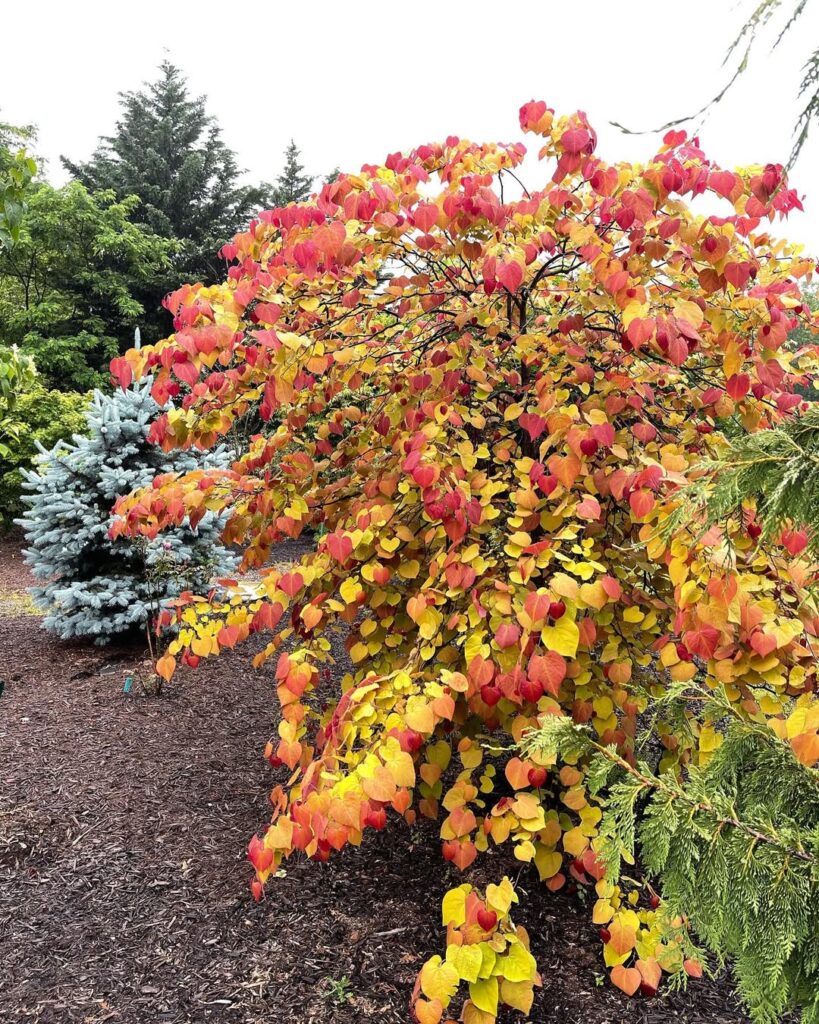
The Eastern Redbud is a stunning native deciduous tree that brings exceptional spring beauty to Missouri landscapes. Growing 20-30 feet tall with a slightly wider spread, this multi-trunked tree produces masses of rosy pink to purplish pea-like flowers on bare branches in March and April before the foliage emerges. The heart-shaped leaves emerge reddish-purple, mature to dark green, and turn yellow in fall.
This adaptable Missouri native thrives in various conditions from open woodlands to rocky terrain, making it an excellent choice for residential landscapes, parks, and naturalized settings. The Eastern Redbud provides valuable ecological benefits by supporting early-season pollinators with abundant nectar and feeding birds and small mammals with its seeds. Its moderate size, low maintenance requirements, and drought tolerance once established make it ideal for sustainable landscaping projects. The flowers provide an important early nectar source for hummingbirds during spring migration.
- Hardiness: USDA zones 4-8, winter hardy across Missouri
- Light: Full sun to partial shade, adaptable to various light conditions
- Water: Moderate water needs, drought-tolerant once established
- Soil: Well-drained soils, adaptable to various site conditions including rocky terrain
- Fertilizer: Low fertilizer requirements, thrives in native soil conditions
- Pest/Disease Resistance: Generally resistant with few serious pest or disease issues
- Growth Rate: Moderate growth rate
Flowering Dogwood (Cornus Florida)
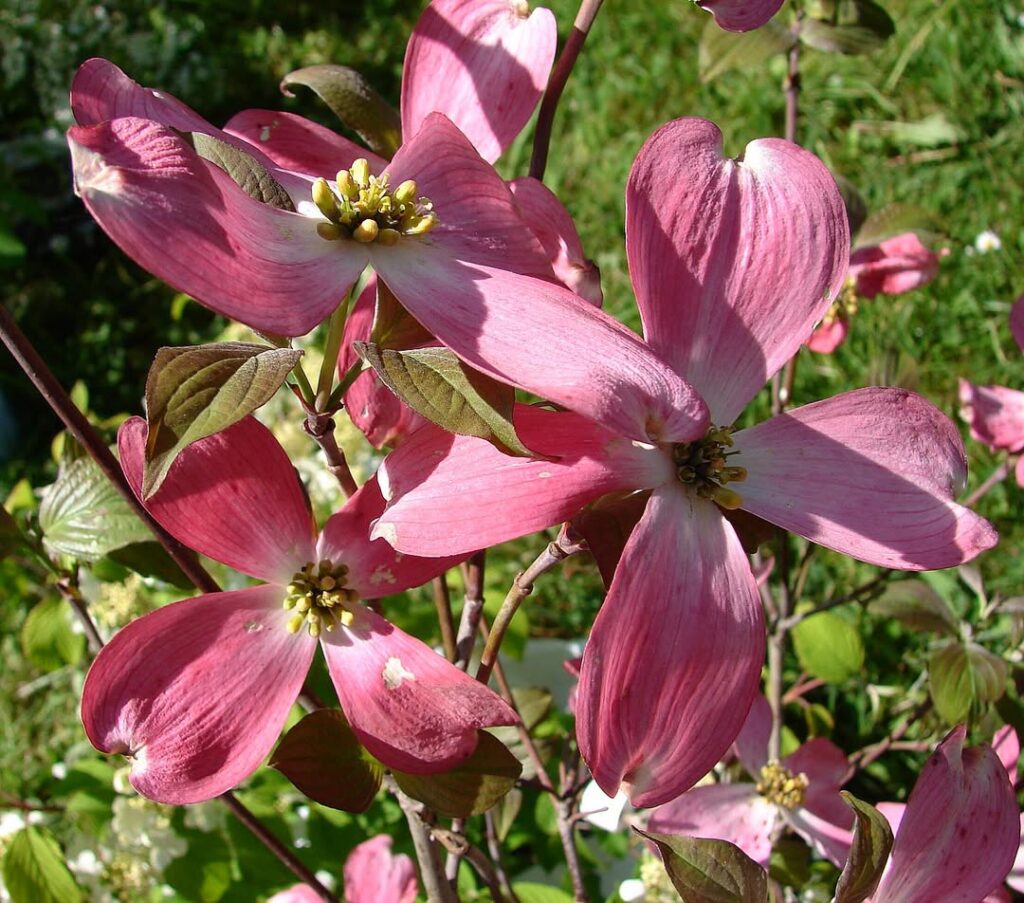
The Flowering Dogwood is Missouri’s official state tree, a small deciduous tree reaching 15-30 feet with a distinctive spreading crown. This native beauty offers year-round appeal with showy white bracts in spring, lush summer foliage, brilliant fall colors, and attractive winter bark. Found throughout Missouri’s forests, particularly in the Ozarks, it serves as a vital understory species.
Beyond its ornamental value, Flowering Dogwood provides essential wildlife habitat and food sources. The bright red berries feed birds and small mammals, while flowers attract pollinators. As a larval host for butterflies and moths, it enhances native ecosystem biodiversity. Its cultural significance extends from traditional uses for tools and dyes to modern landscaping applications. The tree exhibits a low-branching growth habit with a broadly-pyramidal form that becomes somewhat flat-topped at maturity.
- Hardiness: USDA zones 5-9, well-adapted to Missouri’s climate
- Light: Partial to full shade; tolerates some morning sun
- Water: Moderate moisture requirements; drought tolerant once established
- Soil: Well-drained, acidic soils preferred; pH 5.0-6.5
- Fertilizer: Minimal fertilization needed; benefits from organic mulch
- Pest/Disease Resistance: Susceptible to anthracnose and borers; choose resistant cultivars
- Growth Rate: Slow to moderate growth, 1-2 feet per year
Sugar Maple (Acer Saccharum)
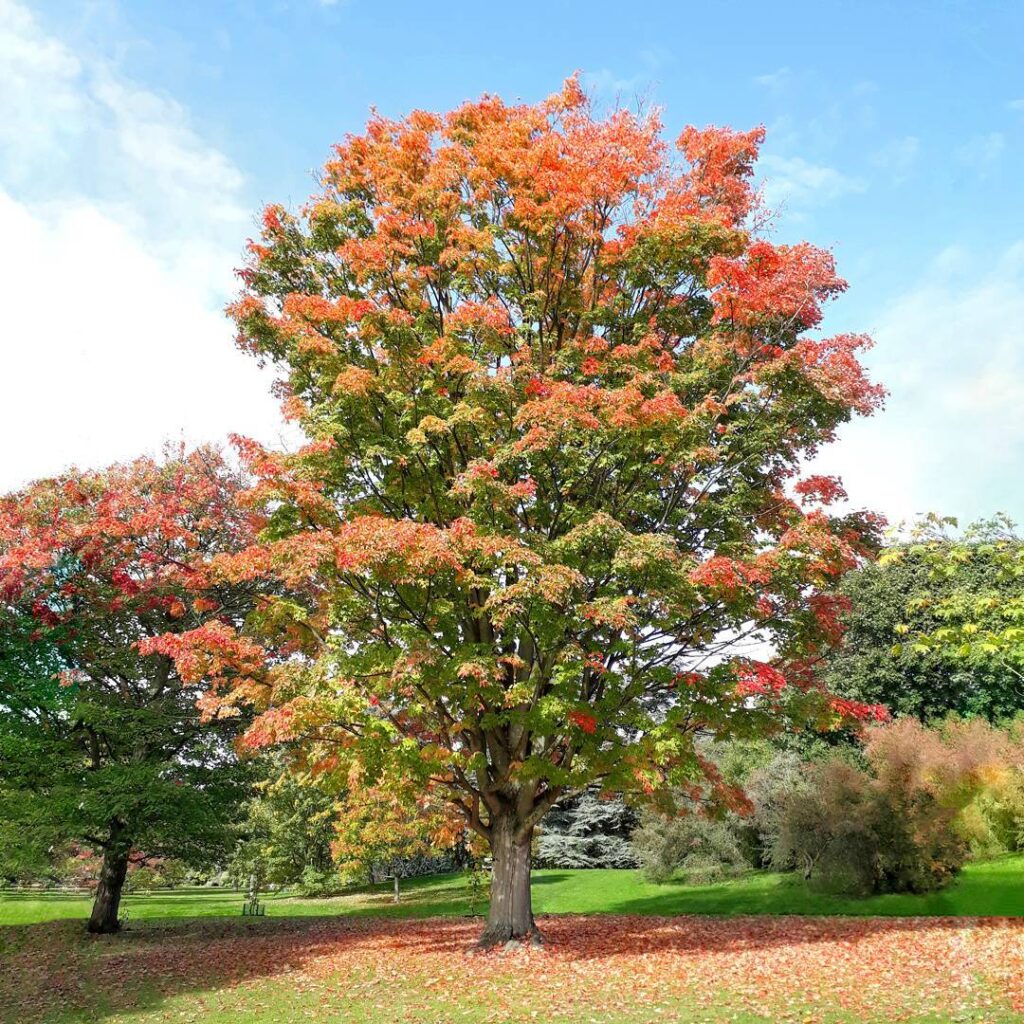
The Sugar Maple stands as one of Missouri’s most magnificent native trees, renowned for its spectacular autumn display of brilliant yellows, oranges, and reds that draws tourists from across the region. This majestic species typically reaches 40-80 feet in height with a dense, rounded crown that provides excellent shade and supports diverse understory vegetation.
Beyond its ornamental value, the Sugar Maple serves critical ecological functions, providing food for wildlife through its seeds and supporting native pollinators during its April-May flowering period. Its strong wood construction and extensive root system make it exceptionally durable against storms while helping prevent soil erosion on slopes. The Sugar Maple holds deep historical significance as Native Americans taught early colonists the traditional techniques for tapping maple syrup.
- Hardiness: USDA zones 4-8
- Light: Full sun to partial shade
- Water: Moderate; drought tolerant once established but thrives with consistent moisture
- Soil: Adaptable to various soil types including clay and loam; prefers medium to wet environments
- Fertilizer: Minimal requirements; thrives in native soils
- Pest/Disease Resistance: Generally good resistance with proper care
- Growth Rate: Slow to moderately fast
White Oak (Quercus Alba)
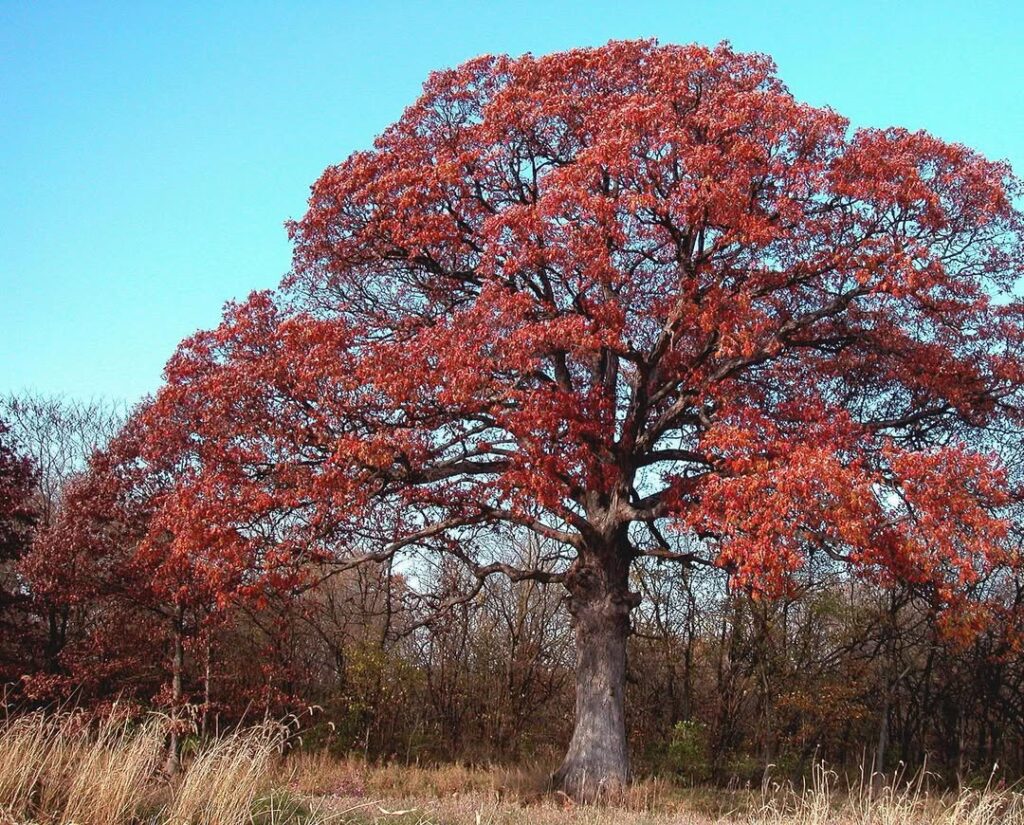
The White Oak (Quercus alba) stands as Missouri’s most majestic native tree, reaching impressive heights of 80-100 feet with a massive canopy spread. This long-lived deciduous giant displays distinctive smooth-lobed leaves that emerge pinkish-white, mature to medium green, and transform to brown or wine-red in fall. Its ash-gray, scaly bark and medium-sized smooth acorns make it easily recognizable.
Beyond its striking appearance, White Oak serves as an ecological powerhouse, hosting over 500 butterfly and moth species while providing essential acorn crops for wildlife. This durable tree thrives on dry upland slopes throughout Missouri’s forests, adapting its form to growing conditions—tall and stately in woodlands, shorter and more massive in open areas. The tree produces yellowish-green flowers in May, adding subtle beauty during its blooming period.
- Hardiness: Zones 3-9, extremely cold hardy and adaptable to Missouri’s climate variations
- Light: Full sun to partial shade, performs best with at least 6 hours of direct sunlight
- Water: Drought tolerant once established, prefers moderate moisture but adapts to dry conditions
- Soil: Well-drained soils preferred, tolerates all but the driest shallow soils, pH adaptable
- Fertilizer: Low maintenance, rarely needs supplemental feeding in natural settings
- Pest/Disease Resistance: Generally excellent resistance, very few serious pest or disease issues
- Growth Rate: Moderate to slow, though modern cultivation techniques have improved growth rates
American Basswood (Tilia Americana)
American Basswood (Tilia americana) is a magnificent deciduous tree native to Missouri, reaching heights of 50-80 feet with an attractive ovate-rounded crown. This fast-growing species produces fragrant pale yellow flowers in late spring that are highly valued by pollinators, followed by small, hairy fruits in late summer. Known for its dark green foliage that turns bright yellow in autumn, American Basswood thrives throughout Missouri’s diverse habitats from rich woodlands to stream banks, making it an excellent choice for both natural landscapes and urban plantings. The tree’s edible flowers provide a unique culinary opportunity while also serving as an important nectar source for bees.
- Hardiness: USDA zones 2-8
- Light: Full sun to partial shade
- Water: Medium to moist; tolerates both dry upland conditions and consistently moist soils
- Soil: Adaptable to various soil types; prefers rich, well-drained soils but tolerates clay and sandy conditions
- Fertilizer: Low maintenance; benefits from organic matter but does not require regular fertilization
- Pest/Disease Resistance: Moderate; susceptible to aphids, Japanese beetle, linden beetle, anthracnose, and Verticillium wilt
- Growth Rate: Fast-growing
Missouri’s Essential Native Shrubs
Missouri’s native shrubs offer exceptional landscaping solutions, providing environmental benefits, wildlife habitat, diverse growing requirements, and year-round ornamental appeal perfectly suited to local conditions. The Missouri Botanical Garden continues to promote native plant education through its research and community programs at multiple locations throughout the region.
Spicebush (Lindera Benzoin)

Spicebush (Lindera benzoin) is Missouri’s premier native shrub, growing 6-12 feet tall with multiple stems forming a broad, rounded shape. This aromatic deciduous plant produces clusters of tiny yellow-green flowers in early spring before leaves emerge, followed by glossy red fruits later in the season. Both the crushed foliage and fruits emit a distinctive spicy fragrance that gives the plant its common name.
As a dioecious species with separate male and female plants, spicebush thrives in Missouri’s native woodland environments. The smooth-stemmed shrub provides exceptional seasonal interest, from early spring blooms to summer’s aromatic foliage and fall’s colorful berry display, making it an essential component of native landscape designs. The brilliant red fruits on female plants serve as an important food source that attracts birds to the garden throughout late summer and fall.
- Hardiness: Zones 4-9, native to Missouri and throughout North America
- Light: Partial shade to full shade, thrives in woodland conditions
- Water: Moderate to high moisture, prefers consistently damp soil
- Soil: Rich, well-draining woodland soil, adapts to various soil types
- Fertilizer: Minimal requirements, benefits from organic matter and leaf mold
- Pest/Disease Resistance: Excellent resistance, very few pest or disease issues
- Growth Rate: Moderate, establishing slowly but becoming long-lived perennial shrub
Elderberry (Sambucus Canadensis)
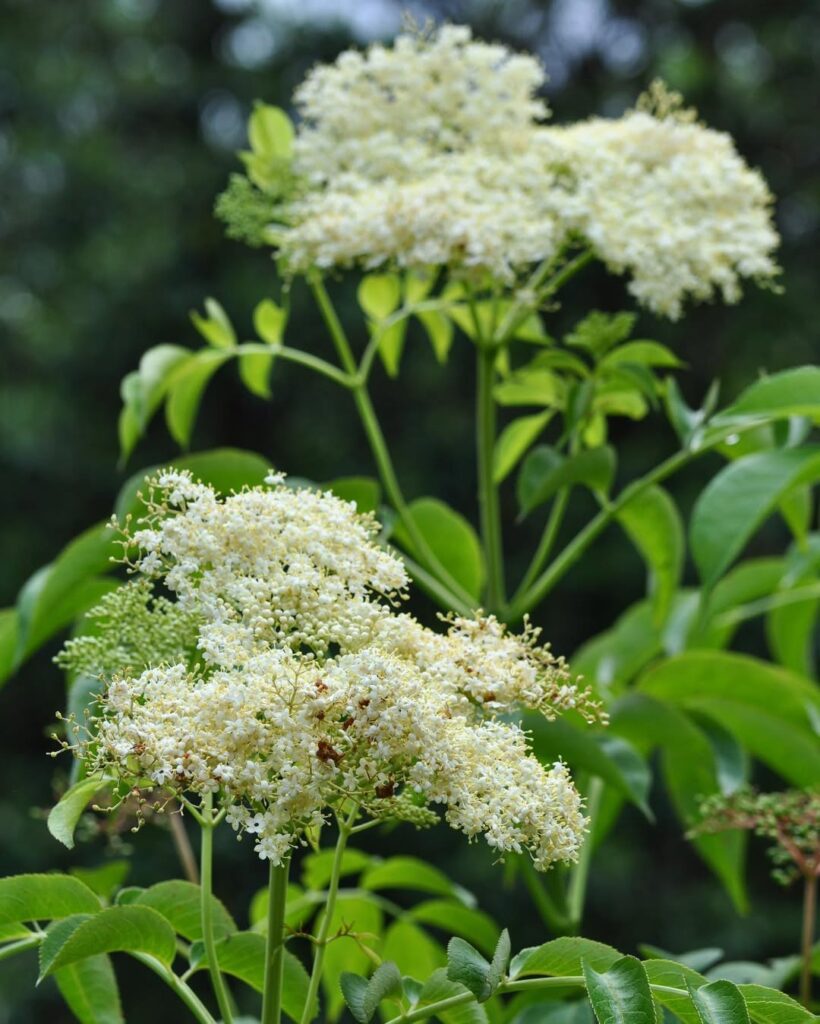
Elderberry (Sambucus canadensis) is a versatile, deciduous shrub that serves as a cornerstone species in Missouri’s native plant communities. Growing 5-12 feet tall and spreading through underground suckers to form beneficial wildlife thickets, this adaptable shrub thrives in diverse habitats from streambanks to prairies and disturbed sites.
The plant offers exceptional four-season interest with fragrant white flower clusters in late spring, dark purple berry clusters by late summer, and lush compound foliage throughout the growing season. Beyond its ornamental value, elderberry provides essential ecological services including pollinator support, wildlife food and shelter, and erosion control along waterways. The ripe berries can be harvested for making jellies, preserves, and wine, though fresh berries should not be consumed raw.
- Hardiness: USDA zones 4-8; hardy throughout all Missouri climate regions
- Light: Full sun to partial shade (2-6+ hours of direct sunlight daily)
- Water: Prefers moist, well-drained conditions but adapts to occasionally wet sites
- Soil: Tolerates clay, loam, and sand; adaptable to various soil types
- Fertilizer: Low-input requirements as a native species
- Pest/Disease Resistance: Relatively pest-resistant with good natural disease tolerance
- Growth Rate: Medium growth rate with moderate maintenance needs
Ninebark (Physocarpus Opulifolius)
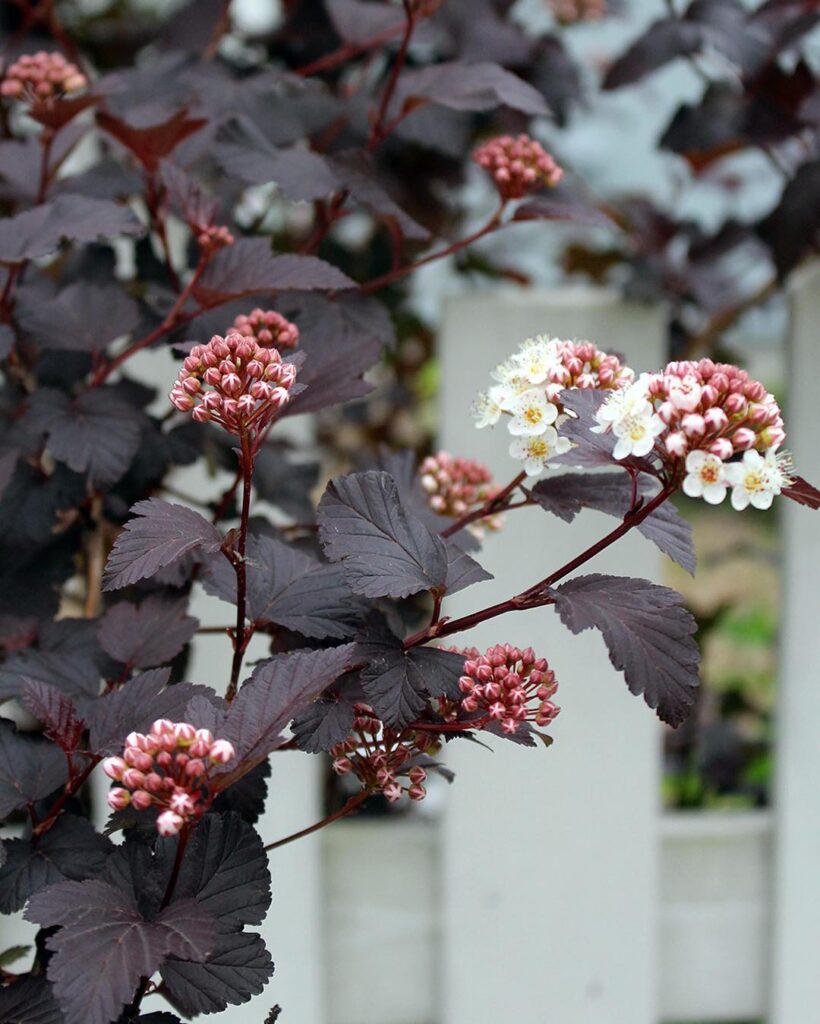
Ninebark is Missouri’s most versatile native shrub, featuring distinctive maple-like foliage and clusters of white flowers that bloom along graceful arching stems. The plant gets its name from the attractive exfoliating bark that peels in layers, providing winter interest after leaves drop. Small red berries follow the flowers, adding summer color while supporting local wildlife.
This hardy shrub forms an upright, vase-shaped specimen that adapts to challenging conditions while maintaining ornamental value. As a Missouri Botanical Garden Plant of Merit selection, ninebark excels in borders, mass plantings, and naturalized areas. It serves as an important host plant for native insects and provides nesting habitat for birds, making it essential for supporting local ecosystems. The shrub is particularly valuable for erosion control on slopes and banks due to its robust root system.
- Hardiness: Zones 3-7, extremely cold hardy
- Light: Full sun to part shade, benefits from afternoon shade in hot climates
- Water: Drought tolerant once established, adapts to wet or dry conditions
- Soil: Tolerates poor soils, prefers well-drained but adaptable to various conditions
- Fertilizer: Low maintenance, typically requires no supplemental feeding
- Pest/Disease Resistance: Excellent resistance with few known problems
- Growth Rate: Moderate, reaching 4-6 feet tall and wide at maturity
Aromatic Sumac (Rhus Aromatica)
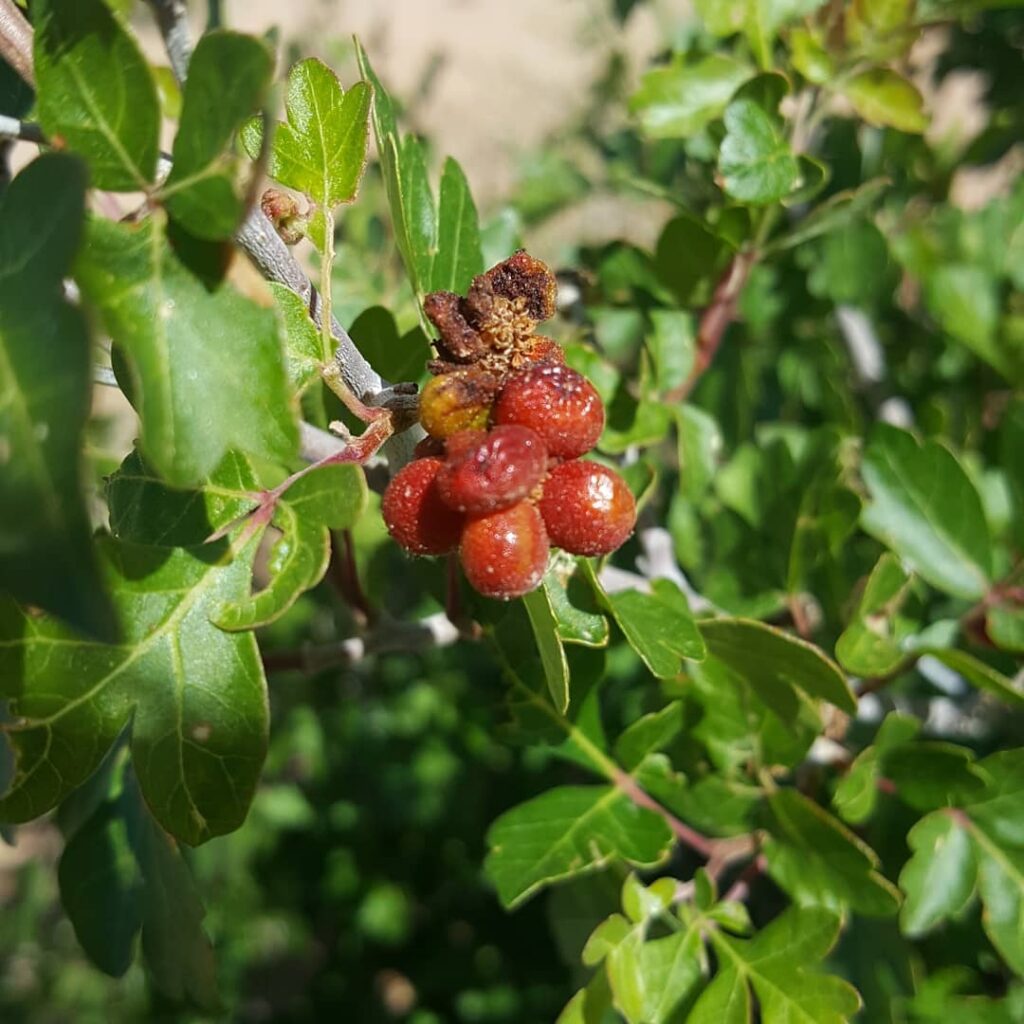
Aromatic Sumac is a versatile deciduous shrub native to Missouri, reaching 6-12 feet in height with an equal spread. This hardy plant forms attractive thickets through natural suckering, making it excellent for erosion control and wildlife habitat. The trifoliate leaves release a pleasant fragrance when crushed and display stunning fall colors in shades of orange, red, and yellow.
Early spring brings clusters of small yellow flowers that appear before the leaves, providing nectar for pollinators. Female plants produce bright red, hairy berries in fall that attract birds and small mammals. The dense branching structure offers valuable nesting cover while suppressing weeds naturally. This low-maintenance shrub integrates beautifully with other native plants and serves as a non-poisonous alternative to poison ivy. Its salt tolerance makes it particularly valuable for challenging coastal or roadside environments where other plants struggle.
- Hardiness: USDA zones 3-9
- Light: Full sun to full shade
- Water: Drought tolerant once established; average moisture
- Soil: Adaptable to dry, sandy, rocky, limestone, clay, or average soils; tolerates various pH levels
- Fertilizer: None required; thrives in poor soils
- Pest/Disease Resistance: Excellent; deer resistant and generally pest/disease free
- Growth Rate: Moderate; spreads readily through suckering to form colonies
Serviceberry (Amelanchier Canadensis)
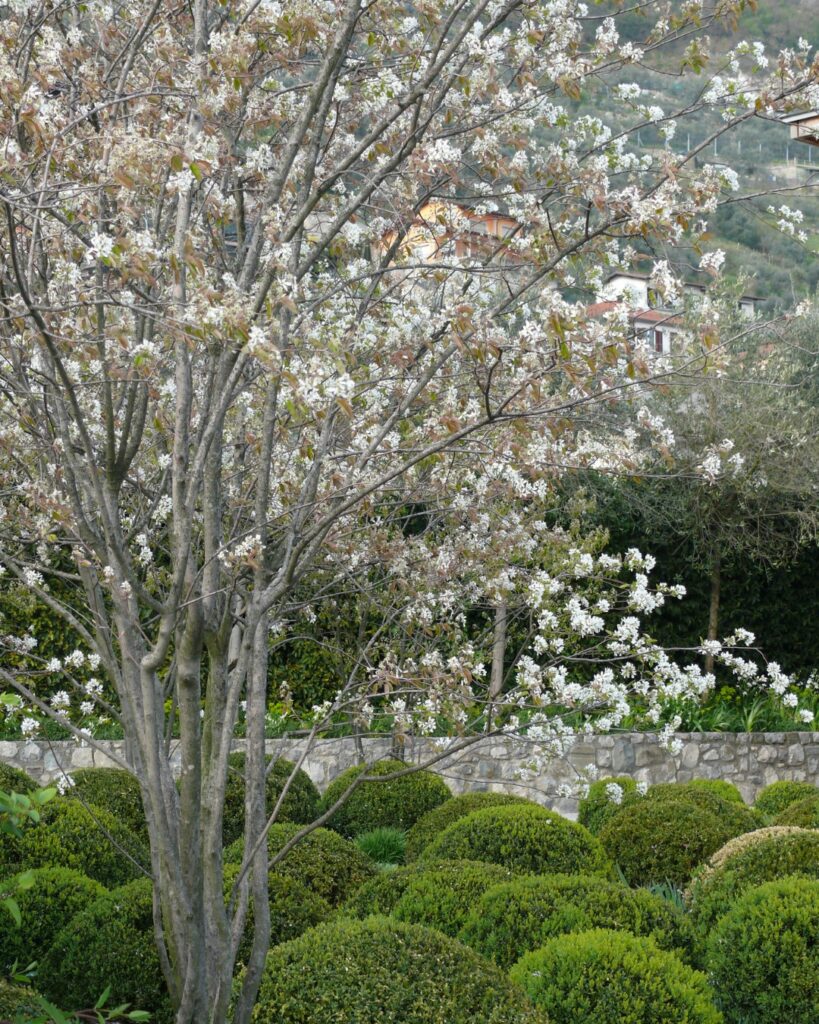
Serviceberry (Amelanchier canadensis) is a versatile native shrub or small tree that reaches 20-25 feet in Missouri landscapes. This early-blooming beauty produces stunning white flowers in April-May before leaves emerge, earning its “Shadbush” nickname from its timing with shad fish runs. The delicate blossoms give way to edible, blueberry-like fruits that ripen to deep red or blackish-purple.
With its smooth grey bark, elegant branching structure, and vibrant orange to rusty-red fall color, serviceberry provides four-season interest. It adapts well to various growing conditions and works perfectly as a specimen plant, in mass plantings, or naturalized settings, making it ideal for small spaces and areas under power lines. This native plant serves as an important browse and food source for birds and wildlife throughout the growing season.
- Hardiness: Native to eastern United States including Missouri
- Light: Full sun to heavy shade
- Water: Moderate; requires decent drainage
- Soil: Adaptable to variety of soil conditions with good drainage
- Fertilizer: Minimal requirements once established
- Pest/Disease Resistance: Generally resistant; occasional rust, leaf spot, blight, powdery mildew, and leaf-eating insects
- Growth Rate: Moderate
Selecting the Right Native Plants for Your Garden
How do you choose native plants that’ll actually thrive in your specific garden conditions? Start with your soil type and sun exposure, since these factors determine which Missouri natives will flourish. Garden design considerations include thinking in layers, beginning with trees as your top tier.
Here’s your native plant selection strategy:
- Assess your site conditions – rocky glade areas need drought-tolerant species like Purple Prairie Clover
- Plan in layers – arrange trees, then shrubs, then perennials for maximum impact
- Group plants together – mass plantings create stronger visual appeal than scattered individual specimens
This systematic approach guarantees long-term success. Visual guides from the Missouri Botanical Garden serve as useful tools for plant selection to help you make informed decisions throughout this process.
Frequently Asked Questions
How Much Do Native Missouri Plants Typically Cost Compared to Non-Native Varieties?
You’ll find native plant pricing considerably higher than non-natives in cost comparison studies. Native quarts cost $6 versus $2.50 for non-natives, while specialty natives reach $12-$18 compared to $2.50 equivalents.
When Is the Best Time of Year to Plant Native Species?
You’ll find spring planting works best from mid-March through early May after frost risk passes. Fall planting from mid-September through November also succeeds, giving roots time to establish before winter.
How Long Does It Take for Native Plants to Become Established?
Native plants’ establishment timeline typically spans 2-3 years, with growth factors like planting method and species selection influencing speed. You’ll see minimal above-ground development initially while roots establish extensively underground.
Do Native Missouri Plants Require Special Fertilizers or Soil Amendments?
You don’t need special fertilizers or soil amendments for native Missouri plants since they’re adapted to native soil conditions. Their minimal fertilizer needs mean established natives thrive without ongoing interventions or synthetic treatments.
Where Can I Purchase Native Missouri Plants and Seeds Locally?
You’ll discover treasures waiting at local nurseries like Missouri Wildflowers Nursery, Forrest Keeling, Sugar Creek Gardens, and SunRise Gardens. Online retailers through Grow Native! connect you with vendors offering seeds and plants.
